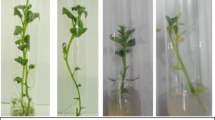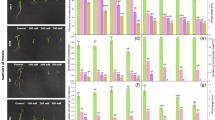Abstract
Salt tolerant cultivars of sweet potato (Ipomoea batatas L.) can be obtained from induced mutation. The objective of the present study was to induce mutation for salt tolerance using ethylmethanesulphonate (EMS) in calli of sweet potato, followed by cell line selection and subsequent plant regeneration. Calli initiated from leaf explants were treated with 0.5% EMS for 0, 1, 1.5, 2, 2.5 and 3 h, followed by rinsing with sterile distilled water for four times. Preliminary experiments showed that 200 mM NaCl could be used as selection pressure. Salt tolerant calli were sub-cultured on medium supplemented with 200 mM NaCl for selection of mutant cell lines and this process repeated 5 times (20 days each). The selected calli were transferred onto somatic embryo formation medium, which was Murashige and Skoog (MS) medium supplemented with 4 mg l−1 abscisic acid (ABA), 10 mg l−1 gibberellic acid (GA). After 15 days, somatic embryos were transferred onto MS medium supplemented with 0.05 mg l−1 ABA, 0.2 mg l−1 zeatin (ZT) for regeneration. Plants designated as ML1, ML2 and ML3 were regenerated from the somatic embryos formed by calli treated with 0.5% EMS for 2 and 2.5 h. After propagation, salt tolerance of these mutants was investigated. Data suggested the mutants were more salt tolerant than control plants.

Similar content being viewed by others
Abbreviations
- EMS:
-
Ethylmethanesulphonate
- MS:
-
Murashige and Skoog
- ABA:
-
Abscisic acid
- GA:
-
Gibberellic acid
- ZT:
-
Zeatin
- 4FA:
-
4-fluorophenoxyacetic acid
References
Bhagwat B, Duncan EJ (1998) Mutation breeding of banana cv. Highgate (Musa spp., AAA Group) for tolerance to Fusarium oxysporum f. sp. cubense using chemical mutagens. Sci Hortic 73:11–22
Carlson PS (1970) Induction and isolation of auxotrophic mutants in somatic cell cultures of Nicotiana tabacum. Science 168:487–489
Duron M (1992) Induced mutations through EMS treatment after adventitious bud formation on shoot internodes of Weigela cv. Bristol ruby. Acta Hortic 320: 113–118
Ekanayake IJ, Dodds JH (1993) In vitro testing for the effects of salt stress on growth and survival of sweet potato. Sci Hortic 55:239–248
Flick CE (1983) Isolation of mutants from cell culture. In: Evans DA, Sharp WR, Ammirato PV, Yamada Y (eds) Handbook of plant culture. New York, Macmillan 1:393–441
Huang DJ, Lin CD, Chen HJ, Lin YH (2004) Antioxidant and antiproliferative activities of sweet potato (Ipomoea batatas [L.] Lam’Tainong 57’) constituents. Bot Bull Acad Sin 45:179–186
Kirti PB, Hadi Kumar PA, Chopra VL (1991) Production of sodium chloride-tolerant Brassica juncea plants by in vitro selection at the somatic embryo level. Theor Appl Genet 83:233–237
Lu W, Jia JF (1994) Selection of NaCl-tolerant Cell Line from embryogenic calli of millet and Studies on Its Physiologial and Biochemical Characteristics. Acta Agronomica Sinica 20:241–247
Mirza JI, Saeed HM (1997) A mutation at AP2 locus of Arabidopsis confers spermine resistance. Biol Plant 40(1):67–73
Murashige T, Skoog F (1962) A revised medium for rapid growth and bio assays with tobacco tissue cultures. Physiol Plant 15:473–479
Nabors MW, Daniels A, Nadolny L, Brown C (1975) Sodium chloride tolerant lines of tabacco cells. Plant Sci Lett 4:155–159
Robbie Waugh, David J. Leader, Nicola McCallum, David Caldwell (2006) Harvesting the potential of induced biological diversity. Trends Plant Sci 11:71–79
Sihachakr D, Haicour R, Cavalcante Alves JM, Umboh I, Nzoghe D, Servaes A, Ducreux G (1997) Plant regeneration in sweet potato (Ipomoea batatas L., Convolvulaceae). Euphytica 96:143–152
Sumaryati S, Negrutiu I, Jacobs M (1992) Characterization and regeneration of salt- and water-stress mutants from protoplast culture of Nictiana plumbaginifolia (Viviani). Theor Appl Genet 83:613–619
Van Harten AM (1998) Mutation Breeding: Theory and Practical Applications. Cambridge University Press, London
Author information
Authors and Affiliations
Corresponding author
Rights and permissions
About this article
Cite this article
Luan, YS., Zhang, J., Gao, XR. et al. Mutation induced by ethylmethanesulphonate (EMS), in vitro screening for salt tolerance and plant regeneration of sweet potato (Ipomoea batatas L.). Plant Cell Tiss Organ Cult 88, 77–81 (2007). https://doi.org/10.1007/s11240-006-9183-2
Received:
Accepted:
Published:
Issue Date:
DOI: https://doi.org/10.1007/s11240-006-9183-2




